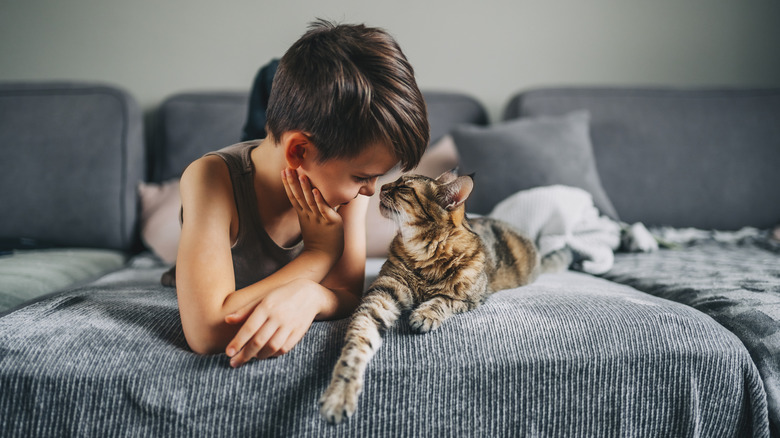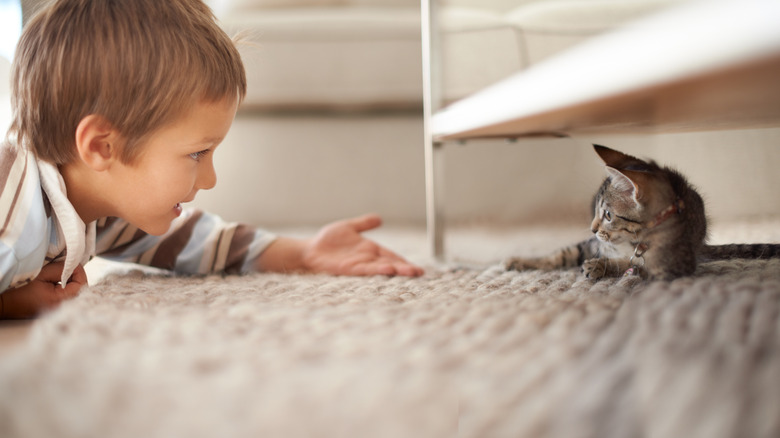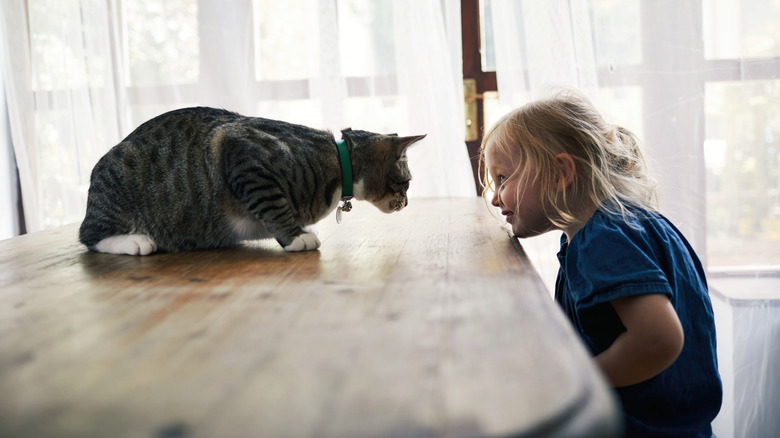Always Follow These Steps When Introducing Your Child To A New Cat For Adorable Results
Witnessing a child meet the new family cat can be an exciting, photo-worthy moment that sets the stage for a deep, long-lasting bond between the two. In order for it to be safe and joyful, though, you'll need to plan ahead, regardless of your child's or cat's age. Cats are sensitive animals, and kids can behave unpredictably, so it's important to consider the potential responses of both before arranging the first encounter. For a successful introduction, show and tell your child about all the do's and don'ts regarding cat handling and feline behavior. You should also choose a quiet space for the intro and let your cat freely sniff your child.
Your primary goal is to make sure that both your child and new furry companion feel secure and respected with the first and every interaction. Whether your kiddo is an infant, toddler, or older child, each age group requires a different level of guidance, especially if they've never interacted with a cat before. Following these steps can help create an adorable, positive connection from day one so your kitty can get started off on the right paw in your home.
Show your child how to safely touch and handle a cat
Before even allowing your cat and child to meet, take time to teach your little one proper petting and handling techniques. If your child has never touched a cat before, you may need to spend a little extra time with this step. Use a stuffed animal to show them or have them watch a YouTube video. Demonstrate how to use slow, soft strokes on all the cat's sweet spots: the back, on its chin, or on top of its head. Emphasize that the tail, paws, and whiskers are off-limits, at least for the first few interactions.
You should also teach them how to properly pick up a cat, hold it, and place it down, reminding them that cats don't always land on their feet. This lesson is particularly crucial if the cat has claws. Another important thing to teach your child is how to recognize a cat's body language, mostly behaviors that indicate irritation, like hissing, growling, and a flicking tail.
A baby, of course, won't be able to understand any of this, so you'll have to wait until they're older. Until then, plan to supervise any physical interactions between your child and the cat to ensure the safety of both. Keep in mind that babies and young children are known to pull pets' ears and fur, so this is another reason for constant supervision.
Share the do's and don'ts about interacting with a cat
In addition to showing your child how to properly touch and handle a cat, take time to educate them on feline behavior. Tell them about how cats have boundaries that shouldn't be crossed. Give examples of some of the scenarios that can stress out a cat, so they'll know to avoid creating them.
For instance, cats don't typically like being chased, teased, or startled by loud noises. Most also prefer to be left alone while eating and while trying to catch some ZZZ's. After all, don't humans have the same preferences? You should also tell them which household items secretly stress out felines the most so they'll be mindful of those, too.
On the flip side, share with your youngster the positive ways they can interact with your cat, such as with toys. Show them how to safely play with certain toys, and plan to monitor the first several play sessions between your child and cat. Teach your little one the cute and peculiar ways cats show affection, like purring or head bumps, and how they can show love back in a way that your kitty won't be able to resist.
Choose a quiet location for the introduction
Even without a kiddo in the home, your new cat likely will be frightened, curious, and maybe even a little stressed during their first few days with you. It will instinctively want to hide at some point, either before or after exploring the place with its eyes and nose. If it seems extra jittery, you might want to wait until it feels more relaxed before adding more stimuli in the form of a small, curious human. This could take a few days, so be prepared to keep the two separated until you feel the cat has calmed down and adjusted to the home.
Choose a room or area in the home that's quiet and free from external distractions, including the ones that can be seen through a window. Selecting a calm, quiet space increases the odds of a peaceful, positive introduction. Either close the curtains/blinds or just use an area with no windows. Place your cat's solo-play toys or accessories, or both, nearby to create a sense of familiarity and comfort.
If you have a baby, make sure they're also calm and contented, either while in your arms or safely beside you. If your child is old enough to understand you, explain to them the importance of a tranquil setting, and encourage them to speak quietly and not make any sudden movements that could easily startle the cat.
Let your cat sniff your child
Just as with many other animals, cats rely on their sense of smell to learn more about their surroundings, including the people in them. Explain to your child that the cat will approach them and sniff them, encouraging them to remain calm and do nothing. No speaking. No giggling. No petting. No touching. No sudden movements. If you have a baby, let the cat approach them slowly, but if either one of them becomes frightened, hit the brakes and try another day.
It's important for the cat to feel like it's in control of the interaction and not feel forced into it or ruffled by it. As a result, the cat will learn to trust both you and your kid, and fear-based reactions can be prevented. If your pet happens to be a super chill cat that rubs against your child during their very first interaction, take it as a good sign! If you're lucky enough to witness this, you can encourage your son or daughter to give your kitty a gentle head or chin scratch to return the affection.




